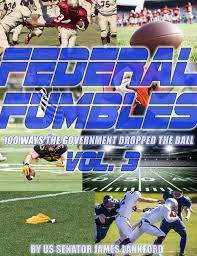
U.S. Sen. James Lankford has released his third “Federal Fumbles: 100 ways the government dropped the ball” when it came to what he considers to be wasteful spending.
Whether it’s a government grant for an art class focusing on climate change, or a doggie Hamlet project in New Hampshire, the Senator is bashing the government for not saving taxpayer’s money.
Take for instance the government’s “How’s My Driving?” program which allows citizens to call and comment on the driving skills of someone behind the wheel of a federal vehicle. But as Sen. Lankford points out, the Food Safety and Inspection Service at the USDA leases 2,245 vehicles from the GSA for its inspectors. This year, the Inspector General reviewed the 43 complaints and found the FSIS had not actually looked at or responded to the complaints—or put in place any procedures to track and respond to the comments.

One that really irked the Senator was the $1 billion the Department of Transportation gave to San Diego to expand its trolley service by about 11 miles. That’s about $100 million a mile. His complaint? How can Oklahoma City build a downtown trolley and pay for it while San Diego can’t? Why are Oklahomans helping San Diego pay for its trolley system?
Now here’s one close to home. FEMA funded tornado shelters given to homeowners like those in Canadian County and Yukon. An estimated $615 million was allocated to the program in FY16.
“While millions of Americans living in or around Tornado Alley fully understand the importance of installing a tornado shelter, not all can afford to do so. Homeowners wishing to take advantage of the program must first pay to install the shelter, ensure the shelter meets FEMA specifications, and then seek a 75% reimbursement for the expense. In Oklahoma, where the average monthly income is $4,047,483 the typical storm shelter costs $2,409.50,484 which means the average family would have to set aside half of its monthly income to purchase a shelter and then wait up to two months to be reimbursed. This is just not feasible for many people,” said the Senator in his report.
His solution?
” FEMA should alter the program to allow payments directly to the company installing the shelters. Homeowners can make a down payment (their required 25% of the total costs) and then the company could bill FEMA for the cost.”
Listen to part of the Senator’s news conference.





